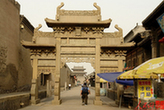Exquisite Furnishings
The Potala Palace is a model not only for its magnificent building, but also its delicate furnishings, including carvings and paintings.
Historical and Religious Implications
The Potala Palace used to be a center for both temporal and religious administration. It is closely connected with many important figures in the history of Tibet, such as Songtsan Gompo, Princess Wencheng and several generations of Dalai Lamas.
c. Tibetan Buddhism
Potala is a transliterated Sanskrit word. It is said that Tibetan Buddhists thought that Mt. Hongshan, the original name of the Potala Mountain, was as pure as Potaraka Mountain, the sacred place where Mother Buddha lived. So they renamed the mountain. When the palace was built, it was named after this sacred mountain.
Tibetan Buddhism believes in the doctrine of Three Realms, that is, the desire realm, the form realm and the form-free realm. The vertical layout of the Potala Palace -- from the Red Palace on the very top to the White Palace at the bottom -- corresponds to that Buddhist doctrine. Expanded size and striking contrast in layout fully demonstrate the power and dignity of Buddhism. The symbolic appearance of the palace indicates that only by detaching oneself from the secular world and converting to Buddhism can one reach the Heavenly Paradise.
d. Legends
Located in Bajiao Street, Lhasa, the Jokhang Monastery was first built in the middle of the 7th century. It is said that Lhasa was still a vast swampland when Princess Wencheng arrived. She found no Buddhist temple there, and had to set up her statue of Sakyamuni in a tent. By observing the terrain of Lhasa, the princess believed that the whole place was just like the figure of a female demon. In order to conquer this demon, the princess decided to fill in the swamp and build a large Buddhist temple. She hoped that the boundless power of Sakyamuni could bring stability and prosperity to the local people. Her proposal was actively supported by Songtsan Gompo. The king ordered the construction at once and he himself even did some of the labor. Two years later, the grand Jokhang Monastery was completed. As it attracted more and more monks, Lhasa became prosperous.
e. Jokhang Monastery (Separate Introduction)
First built in 647, and located in the center of Lhasa City, the Jokhang Monastery is Tibet's oldest wood-and-stone building in existence. With a total area of 25,100 sq. m, the monastery consists of temples and scripture halls. The main Buddhist Hall has four stories, and the gilded copper statue of Sakyamuni brought by Princess Wencheng is still worshipped in its own hall. In front of the monastery stands a monument to the establishment of alliance relations between the Tang Dynasty and Tibet, and the willow tree planted by Princess Wencheng, They are historical evidence of over 1,000 years of friendship between the Han and Tibetan peoples. On the front of the monument is inscribed the history of the monument in both the Chinese and Tibetan languages, and the process and significance of the establishment of the alliance.
Editor: Xu Shenglan





Why not rent a boyfriend, or girlfriend to please parents during the Spring Festival?